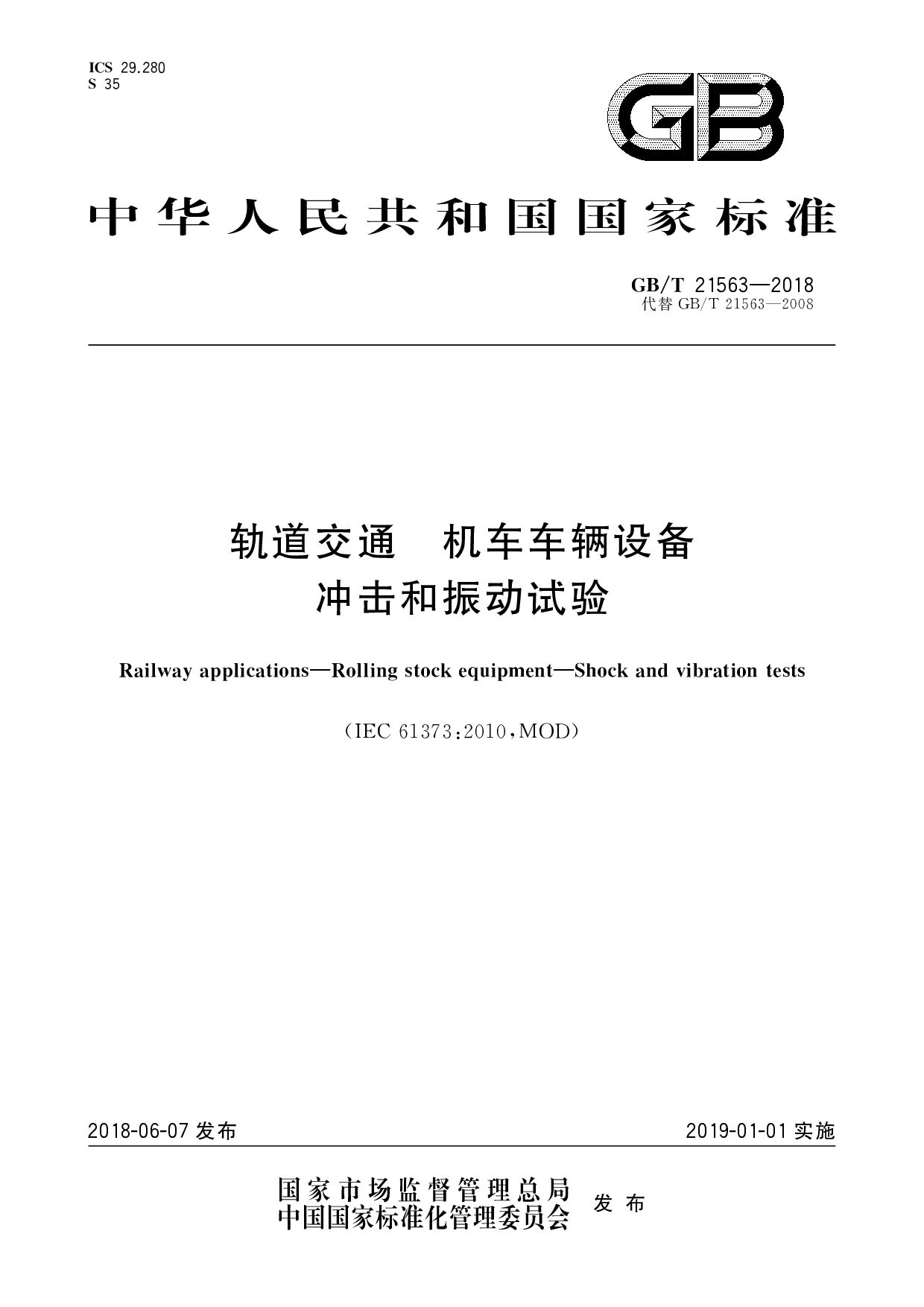GB/T 21563-2018
Railway applications.Rolling stock equipment.Shock and vibration tests

- Standard No.
- GB/T 21563-2018
- Language
- Chinese
- Release Date
- 2018
- Published By
- General Administration of Quality Supervision, Inspection and Quarantine of the People‘s Republic of China
- Lastest
- GB/T 21563-2018
- Replace
- GB/T 21563-2008
- Scope
- This standard specifies requirements for shock and random vibration testing of equipment mounted on rolling stock. Due to the influence of the track operation environment, the equipment on the vehicle will be subjected to shock and vibration. In order to ensure the operation quality of the equipment, it should be tested for a certain period of time by simulating the environmental conditions of the equipment before loading. A variety of methods can be used to simulate long-life vibration tests. These methods have their own advantages and disadvantages. Among them, the most commonly used ones are: a) Amplitude enhancement method: increase the amplitude and reduce the test time; b) Time compression method: retain the original amplitude and reduce the test time. time (increase test frequency); c) amplitude extraction method: when the amplitude is lower than a specific value, remove the time period it occupies in the original data. This standard adopts the "amplitude enhancement method" described in a) above, and together with the referenced documents in Chapter 2, specifies the default test procedure for vibration testing of equipment on rail rolling stock. However, the manufacturer and the user can also use other standards for testing according to the prior agreement. In this case, the verification can not be carried out according to this standard. If effective on-site information can be obtained, the test can be carried out according to the method in Appendix A. If the test magnitude of other standards adopted is lower than the requirements of this standard, the equipment is partially certified to be suitable for this standard (only when the functional vibration test magnitude obtained under field conditions is less than or equal to the specified value in the test report ). This standard is mainly used for rolling stock on the track system, but can also be used for other occasions. For other transportation systems such as pneumatic tires or trolleybuses, because the impact vibration level is obviously different from that of rail systems, the manufacturer and user should reach an agreement on the test level when bidding. The guidelines in Appendix A should be used to determine impact time/magnitude and vibration spectrum. When the test level is lower than this standard, it cannot fully prove that the equipment under test complies with the requirements of this standard. Such as trolley bus, the equipment installed on its car body can be tested according to the requirements of category 1 of this standard. This standard applies to uniaxial tests. Multiaxial tests can also be carried out after prior agreement with the manufacturer and user. This standard only divides the test levels into the following 3 categories according to the installation position of the equipment on the vehicle (see Appendix B): - Type 1 vehicle body installation: ? Cabinets and components directly installed on (or under) the A-level vehicle body , equipment and components; ? Components, equipment and components inside the cabinet directly installed on (or below) the Class B vehicle body. - Type 2 bogie installation: ? Cabinets, components, equipment and parts installed on the bogie of rolling stock. - Type 3 axle mountings: ? Components, equipment and components or assemblies mounted on the wheel set of rolling stock. The test cost depends on the weight, shape and complexity of the tested equipment, so the manufacturer can propose a more cost-effective test method that meets the requirements of this standard when bidding. After adopting an agreed alternative method, it is the manufacturer's responsibility to demonstrate to the user or his representative that the alternative method complies with the requirements of this standard. Once an alternative method is adopted, a certificate shall not be issued as required by this standard. This standard applies to the evaluation of equipment installed on the primary structure of rolling stock (and/or components installed thereon), and does not apply to the testing of components of the primary structure. The main structure mentioned in this standard refers to the car body, bogie and axle. In some cases, the user may require the completion of some additional or special tests, such as: a) equipment installed or connected to vibration sources known to produce fixed vibration frequencies. b) For equipment such as traction motors, pantographs, pantograph shoes, suspension components and mechanical parts designed to transmit force and (or) moment, it may be tested according to their special requirements to confirm that they can be applied to rolling stock superior. In this case, all tests to be carried out shall be agreed at the time of bidding. c) Equipment used in a special environment specified by the user.
GB/T 21563-2018 Referenced Document
- GB/T 2423.43-2008 Environmental testing for electric and electronic products.Part 2:Test method.Mounting of specimens for vibration,impact and similar dynamic tests
- GB/T 2423.57-2008 Environmental testing for electric and electronic products.Part 2: Tests.Test Ei: Shock.Shock response spectrum synthesis
- GB/T 3358.1-2009 Statistics-Vocabulary and symbols-Part 1:General statistical terms and terms used in probability
- IEC 60068-2-27:2008 Environmental testing - Part 2-27: Tests - Test Ea and guidance: Shock
- IEC 60068-2-64:2008 Environmental testing - Part 2-64: Tests - Test Fh: Vibration, broad-band random and guidance
GB/T 21563-2018 history
- 2018 GB/T 21563-2018 Railway applications.Rolling stock equipment.Shock and vibration tests
- 2008 GB/T 21563-2008 Railway application.Rolling stock equipment.Shock and vibration tests